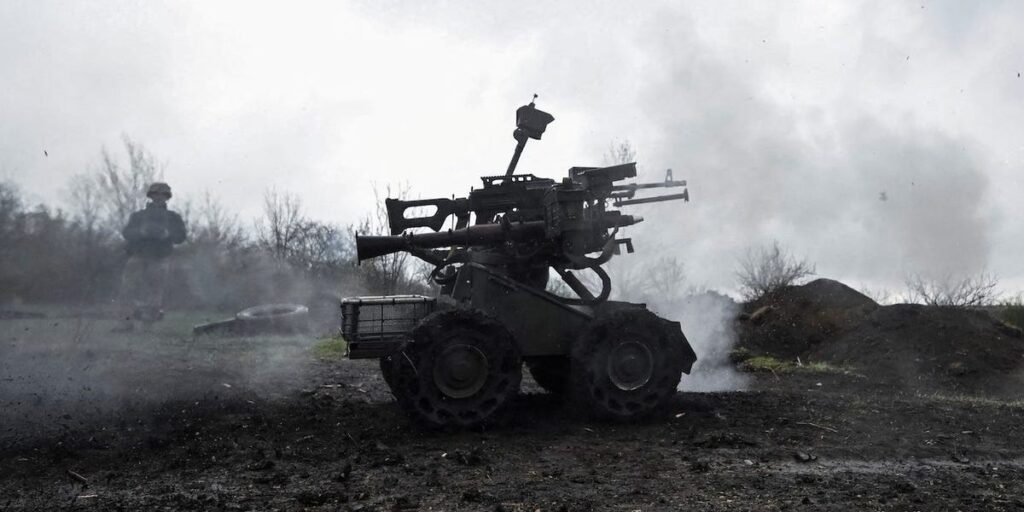Ukrainian soldiers use ground robots to blow up Russian troops and equipment. These carry a far heavier explosive payload than drones that fly.
Operators control these uncrewed ground vehicles, or UGVs, remotely. The UGVs can travel close to Russian positions, assuming they’re not spotted, and detonate. And Ukraine’s soldiers can stay safe and far from the action. They are a lot like flying drones, but the systems pack a greater punch because they don’t take flight.
Oleksandr Yabchanka, the head of the robotic systems for Ukraine’s Da Vinci Wolves Battalion, told Business Insider that Ukraine’s soldiers attach bombs and explosives to ground robots, “turning that system into a kamikaze one.”
The UGV actions mirror what has been done with aerial drones in Russia’s invasion of Ukraine, where the flying drones explode and drop grenades.
“A crucial difference between aerial and on-the-ground unmanned systems is the mass that they can carry,” Yabchanka said. He said Ukraine needs to “always be one step, half a step ahead of the enemy in terms of the powers of destruction.” That’s where these ground drones come into play.
Packing a much bigger punch
He said that while the biggest aerial drones can carry mines that weigh 22 pounds each, the smallest ground robots that he works with can take more than 48 pounds. On average, they can carry much more.
He said that just a few hours before he spoke with Business Insider, his unit sent a ground robot carrying 66 pounds of explosives into a basement held by Russia, where it eliminated Russian infantry.
Ukraine’s soldiers work with a host of drone types linked to do a wide range of work. There are small airborne drones for tactical action ranging from recon to strike and larger aerial uncrewed systems used to hit targets inside Russian territory. There are also naval drones that target ships in the Black Sea, and then there are the UGVs, which can deal damage and carry out missions like casualty evac.
Yabchanka said the growing ground robot technology allows Ukrainian troops to massively amplify their firepower without having to put more soldiers in harm’s way. That’s key when they’re fighting at a disadvantage against Russia’s much larger military army.
He said that roughly 80% of Russians killed in battle are killed by uncrewed systems. The other 20% is mostly artillery — at the start of the war, it was the opposite. Aerial drones are responsible for most of the drone kills because of how prolific they are.
More ground robots could mean a major firepower boost for Ukrainian forces. “Imagine how much more powerful we could be if we could bring twice as much explosives to the front line as we do now,” Yabchanka said.
Unlike the quadcopters, this technology isn’t widely available to all units yet, but where it is being used, UGVs are evacuating wounded soldiers, firing into Russian positions with mounted weapons, carrying gear, laying mines, exploding inside enemy positions, and spying on the Russians, and more.
An uncrewed arms race
This is a technology that Russia is developing too. Yabchanka said that the question is: who will do it faster?
There’s an effort on both sides of the war to advance this technology. The dynamic echoes the drone race that Ukraine and Russia are both currently locked in, with both sides developing new drones and counter-drone measures to defeat the other side’s drone tech, as well as rushing to make as many drones as possible.
Yabchanka said Ukraine and its partners need to constantly innovate to keep coming out with new ground robot upgrades and improvements to other military technology.
It’s something that requires consistent innovation, as “what was up to date and relevant half a year ago is not up to date and relevant anymore,” he said.
He said they are developing so fast that they are getting upgraded on the actual front lines — with soldiers sometimes making tweaks themselves or calling the manufacturer directly to make a request for changes and upgrades to future drones.
Calling on Ukraine’s partners
Yabchanka called for much greater European involvement in making this type of technology, saying that “whatever is required on our end is at your service.”
Europe, like the US, has given Ukraine billions of dollars in military aid, but Ukraine has increasingly made more and more of its own weaponry as it looks to innovate faster, create weaponry that is designed for a fight with Russia, and overcome shortages in Western aid cause by delays and political debate.
Ukraine has become a pioneer in the development of certain types of weaponry, and European leaders and defense ministers have acknowledged that there are lessons Europe’s defense industries can learn from Ukraine, particularly on drones, as they warn Russia could attack their countries.
Yabchanka said that Europe also has “more resources than Russia,” making deepening cooperation a win-win.
He urged European industry and leaders to get onboard. “The manufacturers, developers, military personnel all stand ready for cooperation. Just come along; we’ll deliver training and whatever else is necessary.”
Read the full article here
















